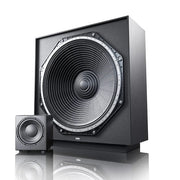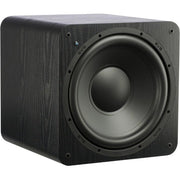If you’re an audiophile, you’ll know that no surround sound system is complete without a good subwoofer. Like your left/right speakers and AV receiver, a subwoofer is essential to the sound quality of any great audio setup.
If you’re new to elevating your audio setup, you may be wondering: what is a subwoofer?
Subwoofers are speakers that reproduce low frequencies, or bass, that standard two-channel systems can’t deliver on their own. A subwoofer allows you to not only hear the bass, but feel the sound too. Watching your favourite action movie without one means you’re not experiencing the film the way the director intended, leaving much to be desired.
But they’re not just for EDM enthusiasts or people who love loud explosions in their movies, they are an essential part of any great surround sound setup. By taking away some of the heavy-lifting from your regular speakers, a subwoofer allows your whole system to sound remarkably better.
We’re here to take away some of the confusion around the concept of LFE inputs and the effect of a good-quality, optimised subwoofer in an audio setup.

Understanding LFE Inputs
Chances are you will have seen a LFE, or Low Frequency Effects, input before—most subwoofers are equipped with an LFE input channel.
But what is LFE input on a subwoofer? Well, put simply, it’s an input port that connects your subwoofer to your AV receiver. It delivers bass-only information and is designed to support overall bass content of the audio or reduce the burden on other channels, thereby enhancing the listening experience and bass response.
LFE channel connections are better suited to home theatre listening than living room entertainment as they greatly enhance the sound effects playing from the systems itself, creating a more immersive experience. LFE channels enhance the amount of low-frequency sounds that come across in the audio signals.

How Do You Connect a Subwoofer to an Amplifier
So, you’ve decided to add a subwoofer to your audio setup… but how exactly do you connect everything up? You may have decided to buy an active subwoofer, which won't need an external amplifier to be connected.
Or, you may have picked a passive subwoofer, which will need an amplifier. Luckily, this is not a complicated process and even if you opt to upgrade your cables or other equipment, the process shouldn’t change much. What is LFE input on a subwoofer used for, you ask? Let’s find out.
To take some of the stress out of setting up your audio equipment, here’s our step-by-step guide answering the question: how do you connect a subwoofer to an amplifier.
- Locate the port on the back of your stereo integrated amplifier or AV Receiver that is labelled ‘LFE’ or ‘Sub Out’ (this is the terminal used to connect the amplifier to your subwoofer).
- Connect your subwoofer cable to this port on the amplifier. If you don’t have one of these you can purchase a high-quality subwoofer cable from CHT Solutions.
- Connect the other end of the cable to the port in the back of the subwoofer, labelled ‘Line In or LFE’.
- To test the set up, insert an audio disc into your system that has deep bass and press play. Set the phase control on the amplifier to zero and the output to minimum. While listening to the audio, adjust the levels until you’re satisfied with the amount of bass coming out of your subwoofer.
Optimising Subwoofer Performance
Chances are, if you’re looking at purchasing a subwoofer, you appreciate the finer details of the audio experience. But what is a subwoofer actually able to add to your audio system?
If you really want to get the most out of the newest addition to your audio setup, you should consider the ways you can optimise its performance to suit your needs. There are a few different elements to consider here.
Placement
The characteristics of your room, such as its size, shape, and materials, greatly influence how sound waves propagate. Experiment with subwoofer placement to find spots where bass response is smooth and not overly boomy or uneven due to room resonances.
Subwoofers are quite often placed near the front of the room, close to the main speakers, or in a central location. However, the exact placement can depend on factors like the layout of your room and personal preferences.
If you have two subwoofers, placing them at opposite ends of the room can help balance out bass response throughout the listening area.
Since each room has unique characteristics, there is no one-size-fits-all approach to subwoofer placement. It's important to experiment by moving the subwoofer around the room and listening for changes in bass quality.
Remember that finding the perfect subwoofer placement might require some trial and error, but the effort is well worth it for achieving a more immersive and balanced audio experience in your home theatre. It's a good idea to listen to various audio content, such as movies, music, and games, while adjusting the subwoofer's position to find the sweet spot for your specific room and preferences.

Settings
Once you've established the best subwoofer placement, it's time to consider the settings. Many audiophiles believe that in most circumstances, it is a good idea to bypass a subwoofer’s internal bass management facilities in favour of the one in your AV receiver. So, what is a subwoofer able to offer your speaker system with an adjustment to its settings? Well, adjusting crossover frequency is an important part of getting your perfect sound.

The crossover frequency refers to the frequency at which your speakers start to roll off and your subwoofer kicks in with LFEs and bass notes. Most AV receivers made nowadays feature an EQ program that automatically assigns the correct crossover frequency based on loudspeaker capability—generally this should be left as-is to achieve a well-balanced audio output. The most commonly recommended crossover frequency is 80 Hz.
Supercharge Your Audio

Ascendo ASC-50SPPS The50 SUB 50" Pro - Passive Infrasonic Sealed Subwoofer

SVS SB1000 Classic Sealed Subwoofer

Ascendo The12 Sub Active Vented Subwoofer 12"

SVS PB-1000 Pro 12" Ported Subwoofer - Black Ash
At CHT Solutions, we believe in the power of a good speaker setup and strive to stock some of the best audio products on offer. From great sounding subwoofers to high-quality AV receivers, we can take care of all your audio equipment needs in one place. Shop our huge range of products today, all designed to raise your home entertainment setup to the next level.







